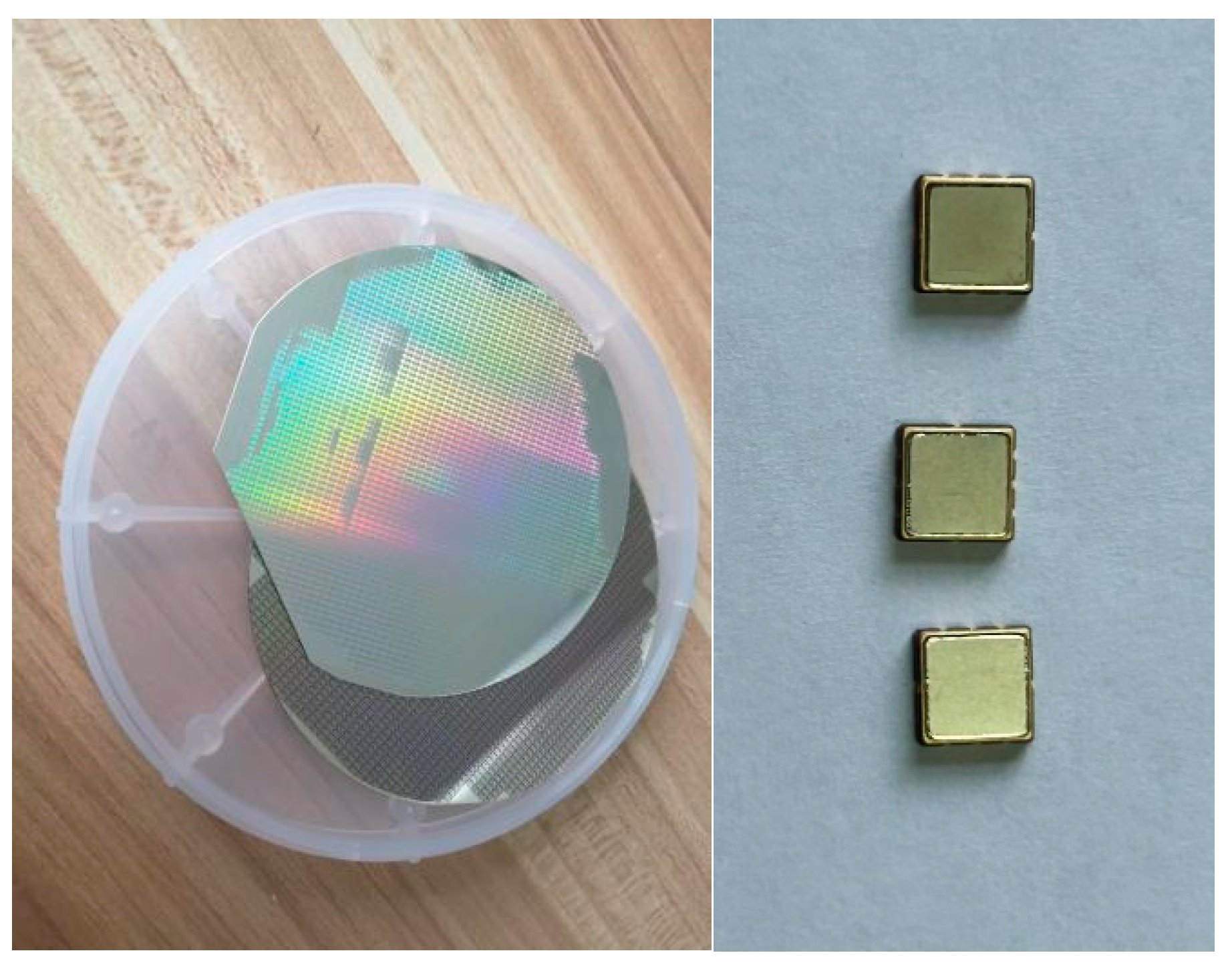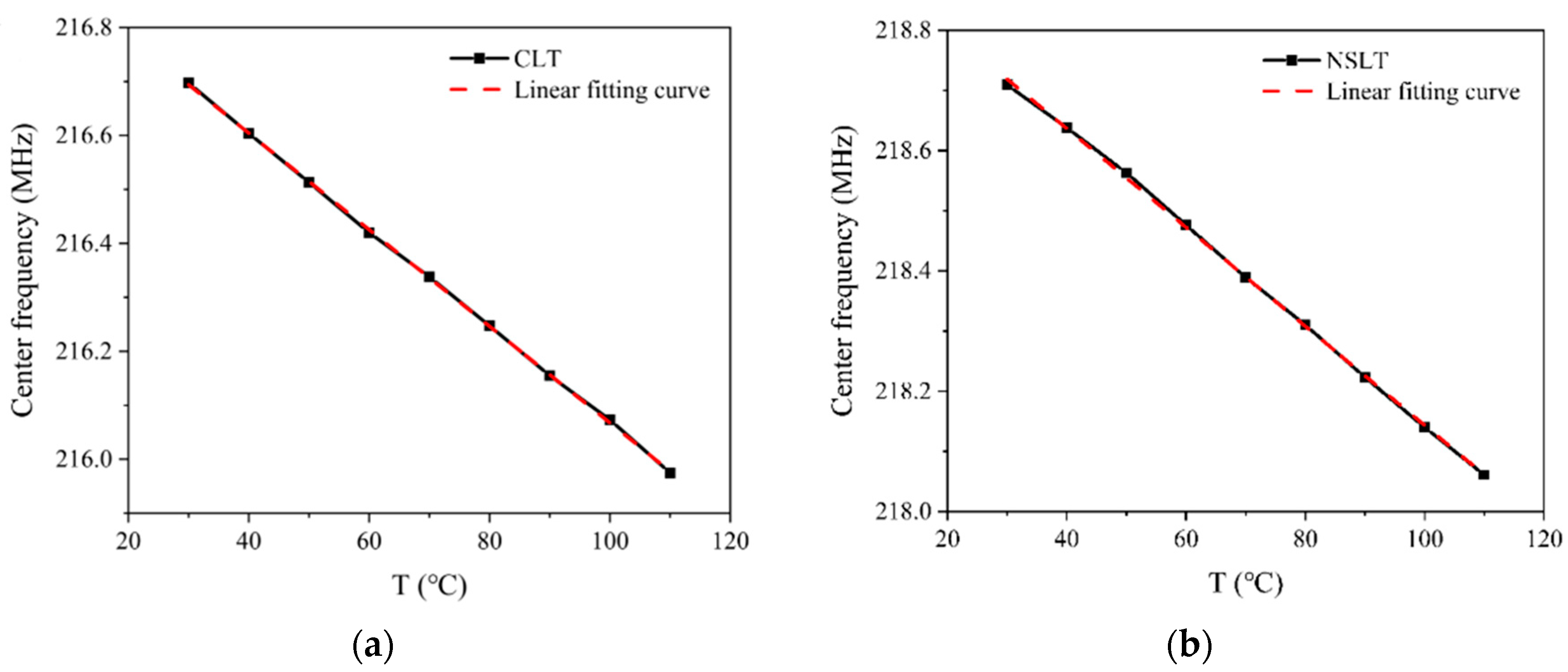Study on the Fabrication and Acoustic Properties of Near-Stoichiometric Lithium Tantalate Crystal Surface Acoustic Wave Filters
Abstract
:1. Introduction
2. Experiment
2.1. Sample Preparation
2.2. Surface Acoustic Wave Filter Fabrication
2.3. Acoustic Performance Testing
3. Results and Discussion
3.1. Temperature Coefficient of Frequency
3.2. Insertion Loss
3.3. Bandwidth
4. Summary
Author Contributions
Funding
Data Availability Statement
Acknowledgments
Conflicts of Interest
References
- Kawachi, O.; Mineyoshi, S.; Endoh, G.; Ueda, M.; Ikata, O.; Hashimoto, E.; Yamaguchi, M. Optimal cut for leaky SAW on LiTaO3 for high performance resonators and filters. IEEE Trans. Ultrason. Ferroelectr. Freq. Control 2001, 48, 1442–1448. [Google Scholar] [CrossRef] [PubMed]
- Smith, R.; Welsh, F. Temperature dependence of the elastic, piezoelectric, and dielectric constants of lithium tantalate and lithium niobate. J. Appl. Phys. 1971, 42, 2219–2230. [Google Scholar] [CrossRef]
- Kuznetsova, I.E.; Zaitsev, B.D.; Joshi, S.G.; Borodina, I.A. Investigation of acoustic waves in thin plates of lithium niobate and lithium tantalate. IEEE Trans. Ultrason. Ferroelectr. Freq. Control 2001, 48, 322–328. [Google Scholar] [CrossRef] [PubMed]
- Shibata, Y.; Kuze, N.; Matsui, M.; Kanno, Y.; Kaya, K.; Ozaki, M.; Kanai, M.; Kawai, T. Surface acoustic wave properties of lithium tantalate films grown by pulsed laser deposition. Jpn. J. Appl. Phys. 1995, 34, 249. [Google Scholar] [CrossRef]
- Warder, P.; Layus, N. Selecting filters for challenging mobile applications worldwide. Microw. J. 2013, 56, 96. [Google Scholar]
- Yang, J.; Mao, Q.; Shang, J.; Hao, H.; Li, Q.; Huang, C.; Zhang, L.; Sun, J. Preparation and characterization of thick stoichiometric lithium tantalate crystals by vapor transport equilibration method. Mater. Lett. 2018, 232, 150–152. [Google Scholar] [CrossRef]
- Tsutsumi, J.; Inoue, S.; Iwamoto, Y.; Miura, M.; Matsuda, T.; Satoh, Y.; Nishizawa, T.; Ueda, M.; Ikata, O. A miniaturized 3/spl times/3-mm SAW antenna duplexer for the US-PCS band with temperature-compensated LiTaO3/sapphire substrate. In Proceedings of the IEEE Ultrasonics Symposium, Montreal, QC, Canada, 23–27 August 2004. [Google Scholar] [CrossRef]
- Murata, T.; Kadota, M.; Nakao, T.; Matsuda, K.; Hashimoto, K.-Y. Improvement of shape factor and loss of surface acoustic wave resonator filter composed of SiO2/high-density-electrode/LiTaO3. Jpn. J. Appl. Phys. 2009, 48, 07GG05. [Google Scholar] [CrossRef]
- Lakin, K.M. Thin film resonators and filters. In Proceedings of the 1999 IEEE Ultrasonics Symposium Proceedings International Symposium (Cat No 99CH37027), San Diego, CA, USA, 27–29 October 1982. [Google Scholar] [CrossRef]
- Lakin, K.M.; Kline, G.R.; Mccarron, K.T. Development of miniature filters for wireless applications. IEEE Trans. Microw. Theory Tech. 1995, 43, 2933–2939. [Google Scholar] [CrossRef]
- Kline, G.; Lakin, K.; Mccarron, K. Overmoded high Q resonators for microwave oscillators. In Proceedings of the 1993 IEEE International Frequency Control Symposium, Salt Lake City, UT, USA, 2–4 June 1993. [Google Scholar] [CrossRef]
- Hashimotoky, K.M. Recent development of temperature compensated SAW devices. Proc. IEEE Ultrason. Symp. 2011, 79, 86. [Google Scholar] [CrossRef]
- Kao, K.; Cheng, C.; Chen, Y.; Chen, C. The dispersion properties of surface acoustic wave devices on AlN/LiNbO3 film/substrate structure. Appl. Surf. Sci. 2004, 230, 334–339. [Google Scholar] [CrossRef]
- Onishi, K.; Namba, A.; Sato, H.; Ogura, T.; Seki, S.; Taguchi, Y.; Tomita, Y.; Kawasaki, O.; Eda, K. A novel temperature compensation method for SAW devices using direct bonding techniques. In Proceedings of the 1997 IEEE Ultrasonics Symposium Proceedings An International Symposium, Toronto, ON, Canada, 5–8 October 1997. [Google Scholar] [CrossRef]
- Sato, H.; Onishi, K.; Shimamura, T.; Tomita, Y. Temperature stable SAW devices using directly bonded LiTaO3/glass substrates. In Proceedings of the 1998 IEEE Ultrasonics Symposium Proceedings, Sendai, Japan, 5–8 October 1998. [Google Scholar] [CrossRef]
- Miura, M.; Matsuda, T.; Ueda, M.; Satoh, Y.; Ikata, O.; Ebata, Y.; Takagi, H. Temperature compensated LiTaO3/sapphire SAW substrate for high power applications. In Proceedings of the IEEE Ultrasonics Symposium, Rotterdam, The Netherlands, 18–21 September 2005. [Google Scholar] [CrossRef]
- Parker, T.; Schulz, M.; Wichansky, H. Temperature stable materials for SAW devices. In Proceedings of the 29th Annual Symposium on Frequency Control, Atlantic City, NJ, USA, 28–30 May 1975. [Google Scholar] [CrossRef]
- Nakai, Y.; Nakao, T.; Nishiyama, K.; Kadota, M. Surface acoustic wave duplexer composed of SiO2 film with convex and concave on Cu-electrodes/LiNbO3 structure. In Proceedings of the 2008 IEEE Ultrasonics Symposium, Beijing, China, 2–5 November 2008. [Google Scholar] [CrossRef]
- Courjon, E.; Ballandras, S.; Daniau, W.; Baron, T.; Moulet, J.; Signamarcheix, T. LiTaO3/silicon composite wafers for the fabrication of low loss low TCF high coupling resonators for filter applications. In Proceedings of the 2015 Joint IEEEISAF, ISIF, and PFM, Singapore, 24–27 May 2015. [Google Scholar] [CrossRef]
- Tanaka, S.; Kadota, M. IDT-based acoustic wave devices using ultrathin lithium niobate and lithium tantalate. In Proceedings of the 2020 Joint Conference of the IFCS-ISAF, Keystone, CO, USA, 19–23 July 2020; pp. 1–3. [Google Scholar] [CrossRef]
- Kadota, M.; Ishii, Y.; Tanaka, S. Surface acoustic wave resonators with hetero acoustic layer (HAL) structure using lithium tantalate and quartz. IEEE Trans. Ultrason. Ferroelectr. Freq. Control 2020, 68, 1955–1964. [Google Scholar] [CrossRef] [PubMed]
- Chen, Y.; Wu, J.; Zhao, X.; Li, Z.; Ke, X.; Zhang, S.; Zhou, M.; Huang, K.; Ou, X. Heterogeneous integration of lithium tantalate thin film on quartz for high performance surface acoustic wave resonator. Jpn. J. Appl. Phys. 2022, 62, 015503. [Google Scholar] [CrossRef]
- Ballman, A.A. Growth of piezoelectric and ferroelectric materials by the CzochraIski technique. J. Am. Ceram. 1965, 48, 112–113. [Google Scholar] [CrossRef]
- Ohno, Y.; Kubouchi, Y.; Yoshida, H.; Kochiya, T.; Kajigaya, T. Twinning in Czochralski-Grown 36°-RY LiTaO3 Single Crystals. Crystals 2020, 10, 1009. [Google Scholar] [CrossRef]
- Xiao, X.; Xu, Q.; Liang, S.; Zhang, H.; Ma, L.; Hai, L.; Zhang, X. Preparation and defect structure analysis of near-stoichiometric lithium tantalate wafers. RSC Adv. 2022, 12, 19091–19100. [Google Scholar] [CrossRef] [PubMed]
- Xiao, X.; Xu, Q.; Liang, S.; Zhang, H.; Ma, L.; Hai, L.; Zhang, X. Preparation, electrical, thermal and mechanical properties of near-stoichiometric lithium tantalate wafers. J. Mater. Sci.-Mater. Electron. 2022, 33, 20668–20677. [Google Scholar] [CrossRef]
- Kitamura, K.; Yamamoto, J.K.; Iyi, N.; Kirnura, S.; Hayashi, T. Stoichiometric LiNbO3 single crystal growth by double crucible Czochralski method using automatic powder supply system. J. Cryst. Growth 1992, 116, 327–332. [Google Scholar] [CrossRef]
- Jia, B.; Zhao, Y. Near stoichiometric lithium tantalate crystal growth and its periodic polarization. Acta Opt. Sin. 2010, 30, 3249–3252. [Google Scholar]
- Bordui, P.F.; Norwood, R.G.; Bird, C.D.; Carella, J.T. Stoichiometry issues in single-crystal lithium tantalate. J. Appl. Phys. 1995, 78, 4647–4650. [Google Scholar] [CrossRef]
- Campbell, C. Surface Acoustic Wave Devices for Mobile and Wireless Communications, Four-Volume Set; Academic Press: Cambridge, MA, USA, 1998. [Google Scholar]
- Morgan, D. Surface Acoustic Wave Filters: With Applications to Electronic Communications and Signal Processing; Academic Press: Cambridge, MA, USA, 2010. [Google Scholar] [CrossRef]
- Campbell, C. Surface Acoustic Wave Devices and Their Signal Processing Applications; Elsevier: Amsterdam, The Netherlands, 2012. [Google Scholar] [CrossRef]
- Dvoesherstov, M.Y.; Petrov, S.; Cherednik, V.; Chirimanov, A. The temperature coefficients of delay of surface acoustic waves in LGS and LGN crystals in a wide temperature range. Tech. Phys. 2001, 46, 346–347. [Google Scholar] [CrossRef]
- Yamanouch, K. High coupling and zero TCF SH-SAW and SH-Boundary SAW using electrodes/Rotated YX LiTaO3 and SiO2/electrodes/Rotated YX LiTaO3. In Proceedings of the 2013 IEEE IUS, Prague, Czech Republic, 21–25 July 2013. [Google Scholar] [CrossRef]
- Kadota, M.; Nakao, T.; Taniguchi, N.; Takata, E.; Mimura, M.; Nishiyama, K.; Hada, T.; Komura, T. SAW substrate, with coupling factor and excellent temperature stability suitable for duplexer of PCS in US. In Proceedings of the IEEE Ultrasonics Symposium, Montreal, QC, Canada, 23–27 August 2004. [Google Scholar] [CrossRef]
- Busacca, A.; Cherchi, M.; Sanseverino, S.R.; Cino, A.C.; Parisi, A.; Assanto, G.; Cichoki, M.; Caccavale, F.D.; Morbiato, A. Surface periodic poling in lithium niobate and lithium tantalate. In Proceedings of the 2005 IEEE/LEOS Workshop on Fibres and Optical Passive Components, Palermo, Italy, 22–24 June 2005. [Google Scholar] [CrossRef]
- Smith, H.I.; Bachner, F.J.; Efremow, N. A High-Yield Photolithographic Technique for Surface Wave Devices. J. Electrochem. Soc. 1971, 118, 821. [Google Scholar] [CrossRef]
- Zhang, G.; Wenkang, S.; Xiaojun, J.; Tao, H.; Feng, D.; Lianger, L. Temperature characteristics of surface acoustic waves propagating on La3Ga5SiO4 substrates. J. Mater. Sci. Technol. 2004, 20, 63. [Google Scholar]
- Ballandras, S.; Steichen, W. Composants acoustiques utilisés pour le filtrage-Modèles et outils de simulation. 2010. [CrossRef]





| Crystal Orientation | Crystal | Li Concent. (%) |
|---|---|---|
| Y36° | CLT | 48.75 |
| NSLT | 49.34 | |
| 49.75 | ||
| 49.91 | ||
| Y42° | CLT | 48.75 |
| NSLT | 49.8 |
| Li Content in Y36° Wafers (%) | CLT (48.75) | NSLT (49.34) | NSLT (49.75) | NSLT (49.91) |
|---|---|---|---|---|
| TCF of SAW filters (ppm/°C) | −34.85 | −32.93 | −25.68 | −27.5 |
| Temperature (°C) | SAW Filter (CLT) | SAW Filter (NSLT) | |
|---|---|---|---|
| Center frequency (MHz) | 30 | 216.697 | 218.709 |
| 40 | 216.604 | 218.638 | |
| 50 | 216.513 | 218.563 | |
| 60 | 216.42 | 218.476 | |
| 70 | 216.338 | 218.389 | |
| 80 | 216.247 | 218.310 | |
| 90 | 216.155 | 218.223 | |
| 100 | 216.073 | 218.140 | |
| 110 | 215.975 | 218.061 | |
| Theoretical value (ppm/°C) | −42 | ||
| Measured value (ppm/°C) | −41.45 | −37.23 | |
| Temperature (°C) | SAW Filter (CLT) | SAW Filter (NSLT) | ||
|---|---|---|---|---|
| Insertion loss (dB) | 30 | 2.24 | 2.27 | |
| 40 | 2.35 | 2.3 | ||
| 50 | 2.39 | 2.32 | ||
| 60 | 2.48 | 2.31 | ||
| 70 | 2.55 | 2.37 | ||
| 80 | 2.70 | 2.42 | ||
| 90 | 2.78 | 2.47 | ||
| 100 | 2.83 | 2.55 | ||
| 110 | 3.02 | 2.64 | ||
| average value | 2.59 | 2.40 | ||
| Temperature (°C) | Y42° CLT | Y42° NSLT (49.80%) | |
|---|---|---|---|
| SAW filters bandwidth (MHz) | 30 | 7.873 | 7.633 |
| 40 | 7.863 | 7.600 | |
| 50 | 7.851 | 7.607 | |
| 60 | 7.855 | 7.599 | |
| 70 | 7.860 | 7.633 | |
| 80 | 7.858 | 7.639 | |
| 90 | 7.863 | 7.643 | |
| 100 | 7.861 | 7.666 | |
| 110 | 7.849 | 7.699 | |
| average value | 7.859 | 7.635 |
Disclaimer/Publisher’s Note: The statements, opinions and data contained in all publications are solely those of the individual author(s) and contributor(s) and not of MDPI and/or the editor(s). MDPI and/or the editor(s) disclaim responsibility for any injury to people or property resulting from any ideas, methods, instructions or products referred to in the content. |
© 2024 by the authors. Licensee MDPI, Basel, Switzerland. This article is an open access article distributed under the terms and conditions of the Creative Commons Attribution (CC BY) license (https://creativecommons.org/licenses/by/4.0/).
Share and Cite
Si, J.; Xiao, X.; Huang, Y.; Zhang, Y.; Liang, S.; Xu, Q.; Zhang, H.; Ma, L.; Yang, C.; Zhang, X. Study on the Fabrication and Acoustic Properties of Near-Stoichiometric Lithium Tantalate Crystal Surface Acoustic Wave Filters. Crystals 2024, 14, 400. https://doi.org/10.3390/cryst14050400
Si J, Xiao X, Huang Y, Zhang Y, Liang S, Xu Q, Zhang H, Ma L, Yang C, Zhang X. Study on the Fabrication and Acoustic Properties of Near-Stoichiometric Lithium Tantalate Crystal Surface Acoustic Wave Filters. Crystals. 2024; 14(5):400. https://doi.org/10.3390/cryst14050400
Chicago/Turabian StyleSi, Jiashun, Xuefeng Xiao, Yan Huang, Yan Zhang, Shuaijie Liang, Qingyan Xu, Huan Zhang, Lingling Ma, Cui Yang, and Xuefeng Zhang. 2024. "Study on the Fabrication and Acoustic Properties of Near-Stoichiometric Lithium Tantalate Crystal Surface Acoustic Wave Filters" Crystals 14, no. 5: 400. https://doi.org/10.3390/cryst14050400






